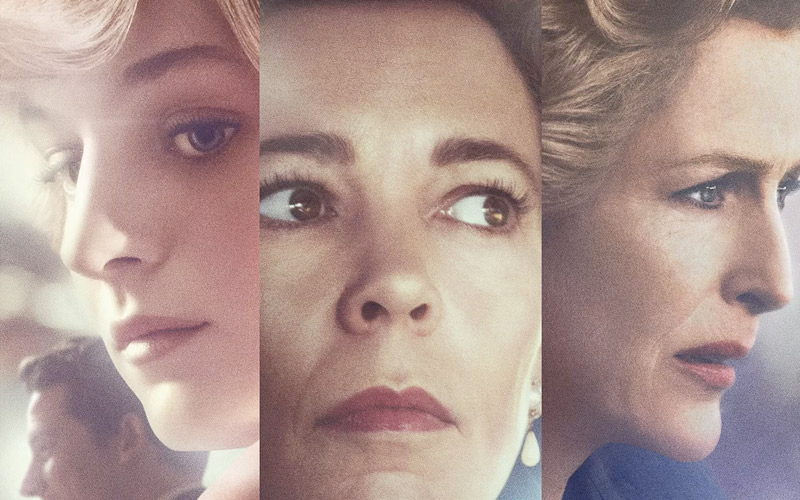‘The Crown’ Season Four Review: “People’s Princess” Turned Human

The Crown Season Four, created by Peter Morgan, follows the British royal family from 1977 to 1990. Until the last episode, Prime Minister Margaret Thatcher runs the United Kingdom with a stern hand. Gillian Anderson and Emma Corrin are a brilliant addition to the cast of powerful women.
The Crown dramatizes events surrounding the royals, so there is a lot of creative licenses taken. The series, which is based on real events, humanizes the British royal family. I want to be clear that I am writing about the fictionalized characters, not the actual royal family.
Margaret Thatcher is neither the villain nor hero in this saga. From the jump, Gillian Anderson as Thatcher is a complicated figure. She is the first female Prime Minister, but not a feminist. Thatcher would be thrilled to close the glass ceiling behind her, thinking that she is the exception, not the norm. She views women as weak.
Margaret often cooks meals for her male Cabinet Ministers. The prime minister serves them as she barks orders about the war with Falklands. Margret is the ultimate control freak who is unwilling to compromise, but at the same time, she acts out domestic tasks. When Margert visits Queen Elizabeth II at Balmoral Castle, she puts away her husband Dennis’s clothes, disgusted that anybody else would do that. It’s extraordinary that the formidable Margaret Thatcher tries to fit into the submissive housewife role. After all, Thatcher heads her household, not Dennis.
Instead of being an icon, Lady Diana Spencer (Emma Corrin) presents as a real person in The Crown. During her life, Diana became the “People’s Princess” who could do no wrong. In the series, her flaws and strengths are revealed.
Prince Charles meets Diana as a shy sixteen-year-old who loves to perform. The future couple connects because they both feel like outsiders in their own homes. When Charles courts Diana, it’s clear that they are part of two different worlds. Diana’s in her late teens and helps out at a local pre-school. She cleans her big sister’s home, then parties with her three roommates in London.
Charles is a thirty-something-year-old man with significant responsibilities who enjoys outdoor activities like gardening and hunting. The match doesn’t work, but the family forces it. All they can see is Diana’s charm. Diana was born into British Nobility, grew up in the country, and seems quite shy. The main problem is that she doesn’t know Charles is already in love with the married Camilla Parker Bowles. Charles’ love affair dooms their marriage from the start.
The marriage between Lady Diana and Prince Charles causes pain for both parties. They are cruel to one another. Even when they were engaged, Charles pays little attention to Diana. She is left alone in Buckingham Palace to learn how to be Princess of Wales from her strict grandmother Lady Fermoy. Diana feels isolated without the warmth of her friends. The pressure mounts to the point where she develops bulimia. Diana’s struggle with bulimia continues throughout the season.
The television show does a great job of not glamorizing bulimia. Diana only suffers from the eating disorder in moments when she feels out of control, like when she realizes how close Camilla is to her fiancé. Prince Charles’ emotional and sexual affair with his mistress continues off and on during the whole season. Diana refuses to go along with things, unlike the rest of the Royal family. If something like going on a royal tour to New Zealand and Australia without her new baby son William displeases Diana, she fights back. Wherever they go, Diana steals Charles’ spotlight by presenting as a friendly “human” alternative to the stuffy aloof royals.
Diana rises in popularity because she hugs an African American boy with AIDS. The adoration she receives distresses Carmilla, who feels like she could never live up to her. Charles and Diana are victims of their forced nuptials.
Elizabeth II has found her footing and power as the Queen. At the beginning of the series, Queen Elizabeth II did not fully understand all of her duties or how the British government worked. Prime Minister Winston Churchill mentored her.
By now, Elizabeth is more experienced than her Prime Minister Margaret Thatcher. She correctly guesses everybody who will be in Thatcher’s cabinet. Elizabeth has her opinions and sticks with them. Queen Elizabeth II and the Commonwealth of nations all want to place economic sanctions on South Africa for Apartheid. Margaret Thatcher refuses to sign the sanction because it would damage the UK’s economy. Queen Elizabeth II goes to war with Thatcher to get her to sign a document condemning South Africa.
The two sent the condemnation back and forth, arguing over the perfect alternative to the word “sanction.” She is no longer the inexperienced young woman who won’t stand up for her beliefs. Queen Elizabeth II fights for her people like unemployed interior decorator Michael Fagan. Fagan breaks into her bedroom in Buckingham Palace. He begs Elizabeth to speak to Margaret Thatcher about how her economic policies cause millions of Brits to lose work without any safety net. The Queen speaks to Michael with compassion and even wishes him good luck when he is arrested. Elizabeth even mentions his plight to Thatcher, but that is all she can legally do.
The Crown Season Four marks the end of the British Empire, the beginning of the unraveling of Prince Charles’ reputation, and the events that lead to Diana’s death.


Responses